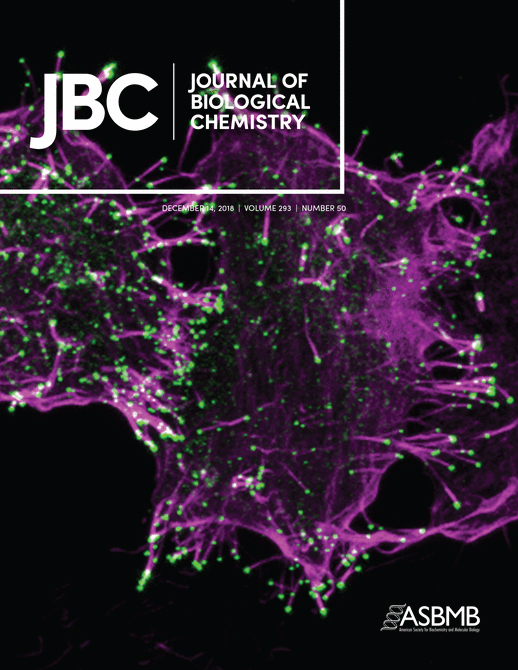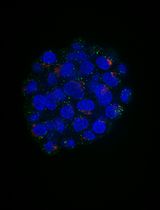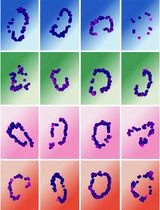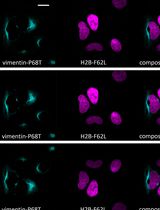- EN - English
- CN - 中文
Lipid-exchange Rate Assay for Lipid Droplet Fusion in Live Cells
活体细胞中脂滴融合的脂类交换速率检测
发布: 2019年07月20日第9卷第14期 DOI: 10.21769/BioProtoc.3309 浏览次数: 7082
评审: David PaulSijie WeiSurabhi Sonam
Abstract
Lipid droplets (LDs) are central organelles in maintaining lipid homeostasis. Defective LD growth often results in the development of metabolic disorders. LD fusion and growth mediated by cell death–inducing DNA fragmentation factor alpha (DFFA)-like effector (CIDE) family proteins are crucial for various biological processes including unilocular LD formation in the adipocytes, lipid storage in the liver, milk lipid secretion in the mammary epithelia cells, and lipid secretion in the skin sebocytes. Previous methodology by Gong et al. (2011) first reported a lipid-exchange rate assay to evaluate the fusion ability of each LD pair in the cells mediated by CIDE family proteins and their regulators, but photobleaching issue remains a problem and a detailed procedure was not provided. Here, we provide an improved and detailed protocol for the lipid-exchange rate measurement. The three key steps for this assay are cell preparation, image acquisition, and data analysis. The images of the fluorescence recovery are acquired after photobleaching followed by the measurement of the intensity changes in the LD pair. The difference in fluorescent intensity is used to obtain the lipid exchange rate between the LDs. The accuracy and repetitiveness of the calculated exchange rates are assured with three-cycle of photobleaching process and the linear criteria in data fitting. With this quantitative assay, we are able to identify the functional roles of the key proteins and the effects of their mutants on LD fusion.
Keywords: Lipid metabolism (脂代谢)Background
Lipid droplets (LDs) play a key role in maintaining lipid homeostasis (Farese and Walther, 2009; Yang et al., 2012). Defective LD maturation and growth are closely associated with the development of metabolic diseases such as obesity, fatty liver disease, cardiovascular disease, and type II diabetes (Krahmer et al., 2013; Rosen and Spiegelman, 2014; Gluchowski et al., 2017). LDs are dynamic organelles which budded from the endoplasmic reticulum (ER) (Gross et al., 2011; Choudhary et al., 2015) and continue to grow via triglyceride synthesis and lipid transfer from the ER (Fujimoto et al., 2007; Wilfling et al., 2013; Xu et al., 2018) or LD fusion (Gong et al., 2011; Somwar et al., 2011). LD-associated cell death–inducing DNA fragmentation factor alpha-like effector (CIDE) family proteins including CIDEA, CIDEB, and CIDEC/Fsp27 (Gao et al., 2017) are crucial regulators in the lipid homeostasis by governing atypical LD fusion and growth for lipid storage. Previously, we reported that CIDEC mediates LD fusion through directional lipid transfer from small (donor) to large (acceptor) LDs (Gong et al., 2011; Somwar et al.). The enrichment of CIDEC at the LD-LD contact site (LDCS) and the formation of the fusion pore are two essential steps for lipid exchange and transfer to occur. To evaluate the fusion ability of each LD pair in cells mediated by the CIDE family proteins and their regulators such as Perilipin1 (Sun et al., 2013a) or Rab8a (Wu et al., 2014), lipid-exchange rate assay was first proposed and performed as previously described (Gong et al., 2011; Sun et al., 2013b). However, the analytic process reported in the previous methodology neither eliminated the photobleaching effect upon laser exposure nor provided a detailed procedure to ensure experimental reproducibility and accuracy.
Here, we detailed the protocol of our renewed lipid-exchange rate assay used in Wang et al. (2018). The three key steps in the assay including cell preparation, fluorescence recovery after photobleaching (FRAP) image acquisition, and data analysis using mean of intensities (MOI) and BODIPY-C12-stained size measurement of LDs were reported. Upon performing a three-cycle photobleaching process and the pre-estimation of exchange rate based on the linear criteria in the data analysis, we can ensure the accuracy and repetitiveness of the fitted exchange rates by using our proposed equation underlying molecular thermodynamics in the Theory section. This lipid-exchange rate assay is also applicable for the evaluation of a nanometer size channel connecting two vesicles when the micrometer volumes of the vesicles are measured in advance.
Materials and Reagents
- Materials
- Pipette tips (Corning, Axygen, catalog numbers: T-1000-B, T-200-Y, T-300)
- 100 mm culture dish (Thermo Fisher, Nunc, catalog number: 150462)
- 35 mm glass bottom culture dish (Thermo Fisher, catalog number: 150682)
- 1.5 ml Eppendorf tube (Corning, Axygen, catalog number: MCT-150-C)
- 50 ml, 15 ml centrifuge tubes (Thermo Fisher, catalog numbers: 339652, 339650)
- Gene Pulser (Bio-Rad, catalog number: 165-2086)
- Biological materials
- 3T3-L1 pre-adipocyte (ATCC, catalog number: CL-173)
- Cidec-GFPN1 plasmid (Wang et al., 2018; available from the corresponding author upon request)
- Reagents
- BODIPY 558/568 C12 (Thermo Fisher, Molecular Probes, catalog number: D3835)
- Sodium oleate (Sigma-Aldrich, catalog number: O7501)
- Dulbecco’s modified Eagle’s medium (DMEM), high glucose, with L-Glutamine and Phenol Red (Gibco, catalog number: 11965084)
- Fetal bovine serum (FBS) (Gibco, catalog number: 16140071)
- Penicillin-streptomycin Mixed Solution (P/S) (Gibco, catalog number: 15140122)
- Electroporation buffer (Bio-Rad, catalog number: 1652676)
- Trypsin-EDTA (Thermo Fisher, Life Technologies, catalog number: 25200-072)
- NaCl (Sigma-Aldrich, catalog number: S3014)
- KCl (Sigma-Aldrich, catalog number: P9541)
- Na2HPO4 (Sigma-Aldrich, catalog number: S5136)
- KH2PO4 (Sigma-Aldrich, catalog number: P9791)
- CaCl2 (Sigma-Aldrich, catalog number: C5670)
- MgCl2 (Sigma-Aldrich, catalog number: M4880)
- Phosphate-buffered saline (PBS) (see Recipes)
Equipment
- Pipettes (Gilson, models: PIPETMAN P10, P20, P200, P1000)
- Cell counting chamber (Easybio, catalog number: BE6138)
- 37 °C, 5% CO2 cell culture incubator (NuAire, model: NU-49SOE)
- Biosafety cabinet (NuAire, model: NU-425-400E)
- Centrifuge (Cence, China, model: TDZ5-WS)
- Electroporation (Lonza, model: Amaxa Nucleofactor II)
- Confocal fluorescent microscope (Nikon Instruments, model: Nikon A1+ Confocal Microscope)
- Live cell station (Oko laboratory, model: A1 Confocal)
- Computer (Lenovo, model: ThinkStation P510)
Software
- NIS-element analysis (Nikon, https://www.microscope.healthcare.nikon.com/products/software)
- Fiji (NIH software, http://fiji.sc/Fiji)
- Open-source plugin-based image analysis software based on ImageJ (https://imagej.nih.gov/ij/)
- LabVIEW 8.5 with a plug-in installation of NI Vision 8.6 module (National Instruments, http://www.ni.com/en-us/support/downloads/software-products/download.labview.html)
- Custom-made LabVIEW modules:
- 1_Exchange rate assay.llb (applied in Step B of Data analysis)
- 2_Check a fitting region.vi (applied in Step C of Data analysis)
- 3_Calculation of exchange rate.vi (applied in Step D of Data analysis)
- Prism 5 (GraphPad Inc.)
Procedure
文章信息
版权信息
© 2019 The Authors; exclusive licensee Bio-protocol LLC.
如何引用
Readers should cite both the Bio-protocol article and the original research article where this protocol was used:
- Wang, J., Chua, B. T., Li, P. and Chen, F. (2019). Lipid-exchange Rate Assay for Lipid Droplet Fusion in Live Cells. Bio-protocol 9(14): e3309. DOI: 10.21769/BioProtoc.3309.
- Wang, J., Yan, C., Xu, C., Chua, B. T., Li, P. and Chen, F. J. (2018). Polybasic RKKR motif in the linker region of lipid droplet (LD)-associated protein CIDEC inhibits LD fusion activity by interacting with acidic phospholipids. J Biol Chem 293(50): 19330-19343.
分类
细胞生物学 > 细胞成像 > 荧光
发育生物学 > 细胞信号传导 > 能量平衡
细胞生物学 > 细胞新陈代谢 > 脂质
您对这篇实验方法有问题吗?
在此处发布您的问题,我们将邀请本文作者来回答。同时,我们会将您的问题发布到Bio-protocol Exchange,以便寻求社区成员的帮助。
Share
Bluesky
X
Copy link















